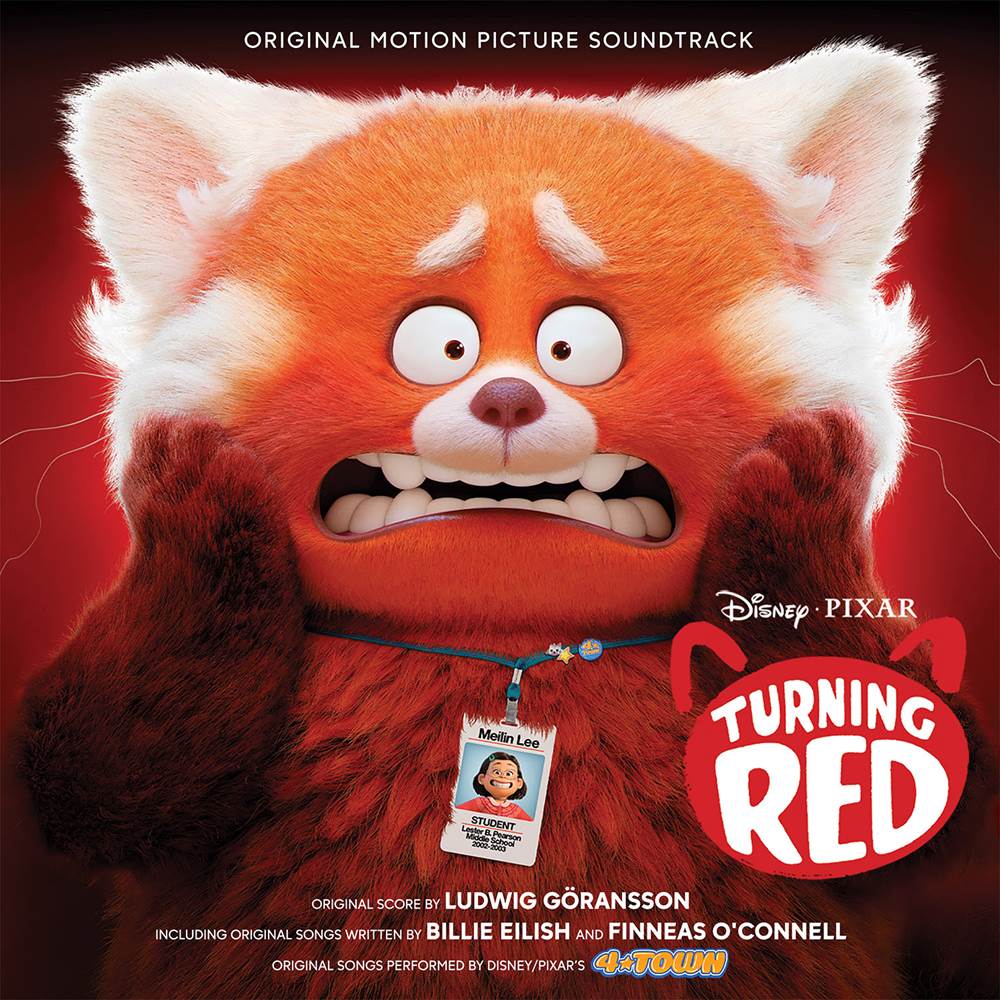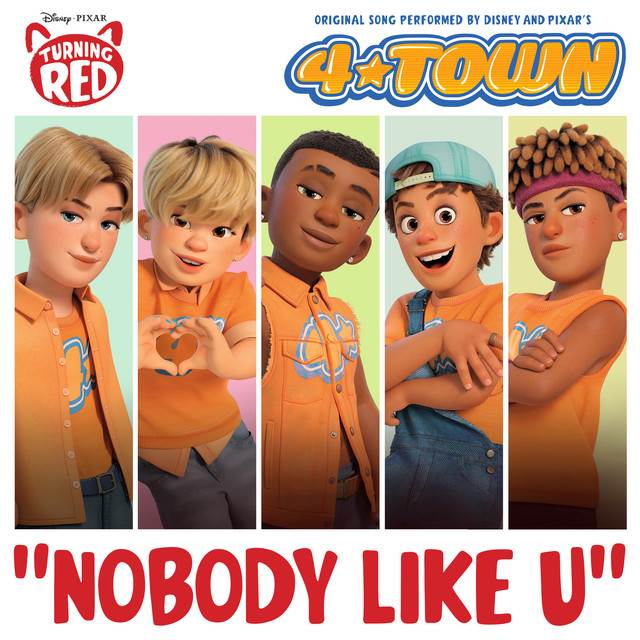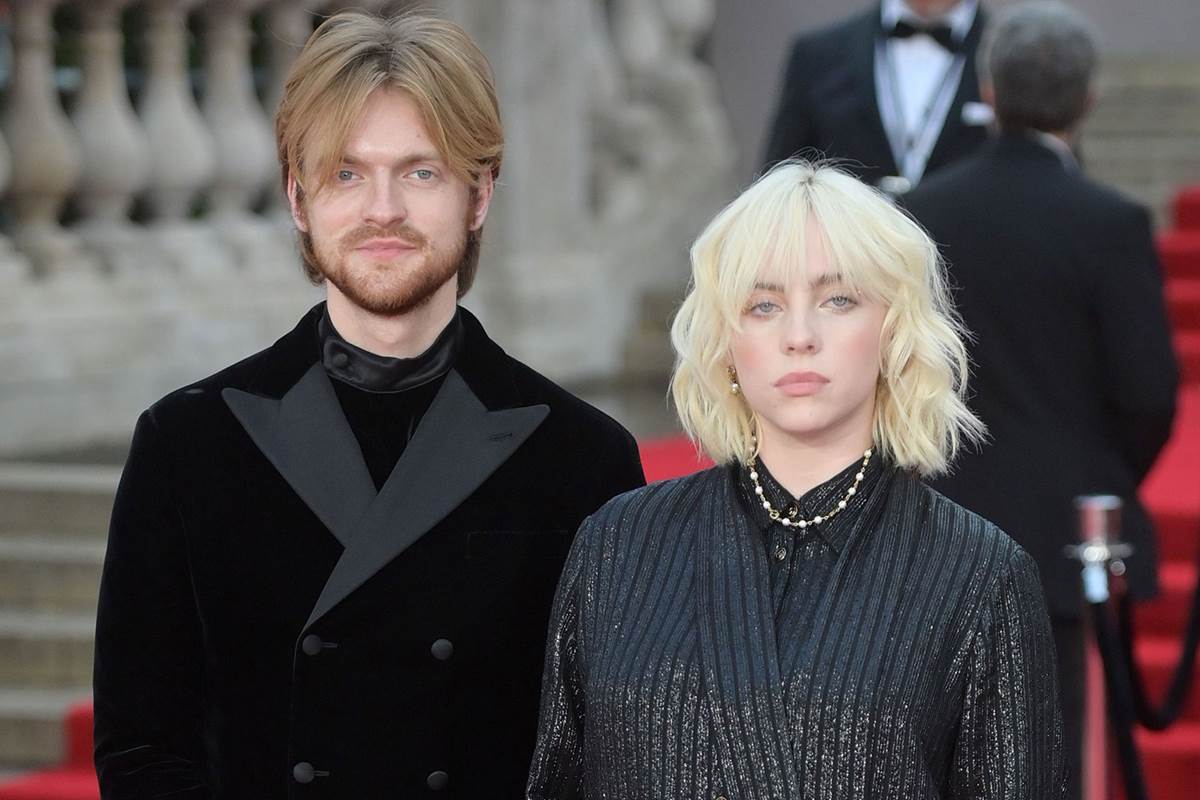A Look Behind the Music of Disney-Pixar’s “Turning Red”
Disney-Pixar’s Turning Red is now streaming on Disney+, which means you can also listen to the soundtrack, featuring songs from Billie Eilish and Finneas O’Connell, and a score composed by Ludwig Göransson.
The Songs:
- According to Turning Red director Domee Shi, if you set a 13-year-old girl’s coming-of-age story in the early 2000s, it’s pretty much mandatory to include a boy band. “We needed our character Mei to be obsessed with something that her mom would not approve of,” said Shi. “Boy bands were the first step into the world of boys for a lot of girls that age. The guys were all super pretty, polished, soft and loving, and they had a way of bringing girls and their besties together. Plus, I thought it’d be really cool to create an animated boy band.”
- Enter Pixar’s first-ever boy band, 4*Town. GRAMMY-winning Music Producer and President of Walt Disney Music Tom MacDougall arranged a meeting with the Turning Red filmmakers and singer-songwriters Billie Eilish and Finneas O’Connell. “When deciding what musical artists to meet with on our films, we don’t look to who’s the most popular, but who’s best suited to the creative needs of the project,” says MacDougall. “In the case of Billie and Finneas, we were lucky to have both.”
- Adds producer Lindsey Collins, “We met with them and pitched this crazy idea of a boy band, asking if they’d be interested in writing and producing the songs. They were!”
- “I don’t know anyone who wouldn’t be interested in working on a Pixar movie,” says O’Connell, the youngest ever to win the GRAMMY for producer of the year (non-classical). Boy band music, he says, “is really like a masterclass in simplicity and memorability. It’s a really catchy melody, harmonies, claps and choreography. It’s so infectious and appealing with these young heart-throbby teens who the kids can’t help but fall in love with.”
- The brother-sister writing team had to channel an era that emerged before they could even talk. “We had to write songs that would be popular in 2000, which at the time, I was one year old,” says Eilish, who made history as the youngest artist to win in all the major categories at the 62nd GRAMMY Awards, receiving awards for best new artist, album of the year, record of the year, song of the year, and best pop vocal album. “But boy bands have a very specific sound, and it’s music I grew up listening to and loved. It was really, really fun to just play around in that world and write in the mind of a corny boy.”
- Filmmakers wanted three songs, each fulfilling a different purpose—and each embracing the style of some of the most popular boy-band songs. “The first one is the hit that everybody knows,” says Shi. “Then there’s the earnest, heart-on-your-sleeve power ballad. The third is the party show-stopper—the fun, energetic song. We knew if we had those three songs, we could use them throughout the movie.”
“Nobody Like U”
- Written to work its way into every listener’s head for hours, “Nobody Like U” is an instant hit. Says O’Connell, “It’s that song that feels like you’ve heard it a million times already—boy bands are so good at doing that. It was such a fun challenge to write a song like that. I love playing with all of the double negatives—‘I’ve never met nobody like you, you’re never not on my mind, you’re never not by my side.’”
- “The lyrics aren’t always good grammar,” adds Eilish. “And they can be hilariously corny—‘I’ve had friends and I’ve had buddies, it’s true. But they don’t turn my tummy the way you do.’ But they’re being honest—they’re trying to say something sweet, profound.”
- “That song is really about friendship, too,” says O’Connell. “The storyboards we’d been given from the film showed the character’s relationship with her friends. I think the coolest thing about all of this music when you’re that age is that you’re internalizing it, right? You take a song written and sung by people older than you and say, ‘This is my song. This is my story.’”
Photo: People
“1 True Love”
- Capable of tugging at heartstrings, “1 True Love” is the kind of song performed to give boy band members a break from choreography. “I love this song,” says Eilish. “I really enjoyed making this one because we just sat down at the piano and got in the mind of this person who’s heartbroken. It’s raining, very melodramatic. ‘Heavy rain on a Saturday when you said my name in the saddest way. Nothing numbs the pain. You’re still the light of my life.’ I just love how dramatic it is. If I heard that song from somebody I was infatuated with when I was 13, I’d be—‘Oh my God! He’s talking to me!’”
“U Know What’s Up”
- Designed to bring a crowd to its feet, “U Know What’s Up” features a sing-along style. Says Eilish, “That was the last one we wrote—and the most challenging. We wanted to make these fans feel confident and independent: ‘I’m gonna make it all the way—just watch me. I’m gonna hustle every day. Making paper like it’s origami. I only came to win the game. Can’t stop me.’”
- “We did a whole call-and-response second verse,” adds O’Connell. “It’s a motivational song—that’s the goal.”
The Score:
- Composer Ludwig Göransson, who’s behind the original score for Turning Red, incorporated the 4*Town songs into the score to make it all feel part of the same musical world. “I used a lot of the same sounds and synths that were inspired by the Cheiron studio—the Swedish studio that established the ’90s boy-band sound,” he says. “The boy band is a part of Mei’s identity, so it was important to weave that sound into the score.”
- Director Domee Shi has been a fan of the GRAMMY, Oscar and Emmy-winning composer for a while. “We were drawn to his versatility,” says Shi. “He’s a composer, but he also produces pop music. We knew he would help us create a very unique sound.”
- According to Göransson, the score is eclectic—a musical representation of what it might feel like to be a teenager in the early 2000s. “The score is a clash of cultures as well a clash between the older generation and the new,” he says. “The clash in musical styles also represents Mei’s internal struggle with her own identity. But these conflicts push her forward into her journey of self-discovery.”
- Turning Red is, of course, Mei’s story, so the composer wanted the score to reflect the inner turmoil of a teenager who’s entering adolescence. “There are heightened emotions such as fear, confusion and excitement,” says Göransson. “Throughout the score, I switched genres frequently, almost like a mixtape made by a 13-year-old. Traditional Chinese instrumentation, a 75-piece orchestra, elements of New Jack Swing and ’90s boy band all reflect the confusion in Mei’s mind as she struggles to comprehend what her parents want for her and what she wants for herself. She loves the traditions of her family but she wants to put a new spin on it. I tried to encapsulate that idea through the score.”
- Göransson created character-specific themes for Mei, her mother, Ming, and a third for the red panda. “Mei’s theme is represented by the flute,” he says. “At the beginning of the film, Mei's theme alternates between the western flute and the dizi [a traditional Chinese flute made of bamboo], to reinforce the split in her sense of self.
- “Ming's theme is represented by the guzheng [Chinese plucked stringed instrument],” continues Göransson. “Her theme is traditional, nostalgic and always there to remind Mei of the love that she has for her daughter.”
- The composer had fun with the red panda theme, which he describes as “quirky, grotesque and awkward.” And, like the other themes, the red panda theme incorporates an ancient Chinese instrument, the bianzhong, which is a set of bronze bells to highlight, according to Göransson, “the heightened uncertainty of Mei’s chaotic, emotional state.”
- In addition to the dizi, guzheng and bianzhong, Göransson incorporated other traditional Chinese instruments, including the pipa, a pear-shaped stringed instrument; the erhu, a two-stringed Chinese fiddle; and Chinese opera percussion. These instruments were used to underscore the Lee family heritage and their mystical connection to their ancestor Sun Yee. “Some of these instruments were played traditionally or often unconventionally,” says Göransson, “to reflect the dichotomy of her cultural identity.”
Turning Red is now available to stream on Disney+, and you can find the soundtrack on your favorite streaming platform.
Sign up for Disney+ or the Disney Streaming Bundle (Disney+, ESPN+, and ad-supported Hulu) now






